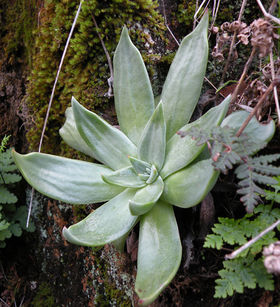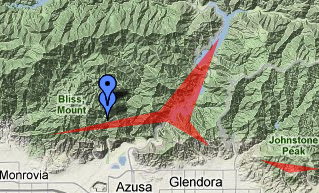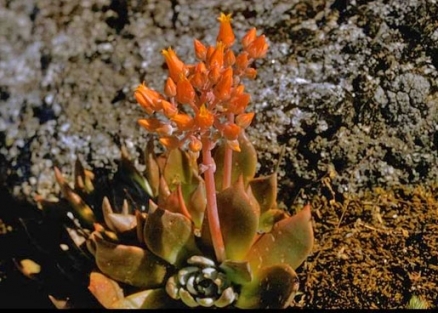Dudleya cymosa (Lem.) Britt. & Rose
Dudleya cymosa (Lem.) Britt. & Rose is a perennial low-growing succulent plant species that is endemic to California. Having a number of subspecies, this fleshy plant is most frequently known as Canyon liveforever. This smooth leaved succulent taxon is quite often found among outcrops on rocky slopes in lower elevation mountains. Some of the subspecies are of highly restricted distribution, and most subspecies are associated with rather specific rock outcrop types as well as well defined mountain ranges. Elevations of occurrence vary from 50 to 2700 meters, with significant differentiation among some of the subspecies.
Contents
Distribution
The species is endemic to California, with distribution including the North Coast Ranges, Cascade Range, Sierra Nevada, Central Western California (except the Central California Coast), and the Transverse Ranges. However, closely related species such as Dudleya farinosa occur on the Central Coast. Each of the eight subspecies have unique distributions, some of the taxa having overlapping ranges.
Taxonomy and genus features
There are a number of characteristics which can be summarized regarding the Dudleya genus. Genus occurrences are restricted to southwest North America; in fact, according to Low, approximately 98 percent of genus occurrences are along or near the coasts of Baja California, (the states of Baja Sur and Baja Norte in Mexico), plus the northward extension into the USA in the states of California and southern Oregon. A small number of genus populations are found in Arizona and possibly Nevada. The center of genus diversity is the coastal region where Mexico and the USA meet. Dudleyas have a strong affinity for the coastal regions, but some species have ranges that extend into the nearby mountains and deserts.
Most species of Dudleya grow at elevations near sea level, but a few grow on or even atop mountains of Baja California, the high Sierra Nevada and in many other California mountain ranges. Many, such as D.cymosa, prefer canyon locations on vertical or near vertical rocky walls, often in the shade, surviving in very little soil in the crevices of almost solid rock. Sometimes the occurrences are in locations that receive no direct sunlight. Almost all Dudleya species have succulent leaves arranged into rosettes. Because of this rosette geometry many genus members are striking in their visual appeal. Many, including the Canyon Liveforever, have leaves that are glaucous (covered with a whitish or bluish waxy coating) or frosty looking.
The chromosome count of all Dudleya species is n=17, with about 35% of all populations consisting of polyploids (individuals with multiples of the base number). Remarkably, according to extensive crossing experiments conducted by Verity, all Dudleya taxa are capable of hybridizing in nature.
There are eight recognized subspecies of D. cymosa (flower color in parentheses):
- D. cymosa subsp. agourensis K.M.Nakai: Canyon Liveforever (bright yellow)
- D. cymosa subsp. crebrifolia K.M.Nakai & Verity: San Gabriel River dudleya (mustard yellow)
- D. cymosa subsp. costafolia Bartel & Shevock: Pierpoint Springs Dudleya (bright yellow)
- D. cymosa subsp. cymosa: Canyon Liveforever, the nominate subspecies (bright yellow, red or orange)
- D. cymosa subsp marcescens Moran: Marescent Dudleya (bright yellow with orange or red markings)
- D. cymosa subsp ovatifolia: (Britton) Moran Santa Monica Mountains Dudleya (bright yellow, rarely with red or orange marking)
- D. cymosa subsp. paniculata: (Jeps.) K.M.Nakai (pale yellow-white to pale yellow-pink)
- D. cymosa subsp. pumila: (Rose) K.M.Nakai (bright yellow or red)
Species description
 D.cymosa, Sonoma County, Ca. Source: C.Michael Hogan
D.cymosa, Sonoma County, Ca. Source: C.Michael Hogan
Dudleya cymosa is a perennial succulent plant with a generally short, sometimes woody, more or less vertical stem of a perennial, at or beneath ground level caudex that ranges from 0.2 to 3.5 centimeters (cm) wide, which may be branched or unbranched. The leaves are glaucous and fleshy, and generally evergreen. They range from 1.5 to 17 cm in length, and from 0.25 to 5 cm in width. The leaves are generally oblanceolate to spoon-shaped, terminating in an acute apex. These thick leaves are generally glaucous (having a light greyish-blue frosted look) in appearance, not unlike the fleshy look of other succulents. Leaf tips are typically acute or often acuminate to mucronate. The leaves are arranged in a tight basal rosette.
The inflorescence is generally spreading to ascending. The red to yellow or orange flower exhibits individual members of the calyx, whether fused or not; if fused, often equal in number to the number of calyx lobes; generally green. that are 1.5 to 5 millimeters (millimeter = one-thousandth of a meter; one-tenth of a centimeter, mm) long and more or less equilaterally triangular, with the corners rounded or not--deltate-ovate in shape, with a short-tapered, sharp tip, the sides convex or straight and converging at less than a right angle.and Individual member of the corolla, whether fused or not; if fused, often equal in number to the number of corolla lobes; often conspicuously colored. Petals are 7 to 14 mm and 1.5 to 3.5 mm wide, elliptic to lanceolate and narrowly acute.
Further diagnostic distinctions exist among species for leaf wound outcomes, especially in the definition of color associated with the leaf wound. Colors typically vary between various shades of purple to red amongst subspecies.
Habitat
Typical places that the Dudleya cymosa is found include rocky outcrops, slopes and talus habitats at elevations ranging from 50 to 2700 meters. The preferred habitat and distribution of each subspecies is as follows:
- D. cymosa subsp. agourensis: Open rocky volcanic slopes, Santa Monica Mountains
- D. cymosa subsp. crebrifolia: Granite slopes, Fish Canyon, San Gabriel Mountains
- D. cymosa subsp. costafolia: Limestone outcrops, southern High Sierra
- D. cymosa subsp. cymosa: Outcrops or talus of North Coast Ranges, Cascades, Sierra Nevada, Santa Monica Mountains
- D. cymosa subsp marcescens: Volcanic outcrops or slopes of Santa Monica Mountains
- D. cymosa subsp ovatifolia: Outcrops of Santa Monica and Santa Ana Mountains
- D. cymosa subsp paniculata: Outcrops and canyons, San Joaquin Valley, San Francisco Bay Area, Inner South Coast Ranges
- D. cymosa subsp. pumila: Outcrops of Outer South Coast Ranges, Transverse Ranges, Peninsular Ranges
Ecology
Dudleya cymosa is the larval host plant for the Sonoran Blue butterfly, Philotes sonorensis. This plant is well adapted to the shallow rooting requirements common on steep outcrops, and thus is an important species for retaining the integrity of thin soils on such rocky slopes and outcrops. Since some of the subspecies are also adapted to talus, these taxa are important for providing host plants for butterflies and other insects in talus habitats, where flora density is otherwise quite low.
Conservation
 D. cymosa subsp. crebrifolia range, Fish Canyon. Source: Univ. Ca.
D. cymosa subsp. crebrifolia range, Fish Canyon. Source: Univ. Ca.
Five of the subspecies have very restricted distributions and are designated as California Rare Plant Rank (CRPR) 1B.2 by the California Native Plant Society in its Inventory of Rare and Endangered Plants of California. These are:D. cymosa agourensis, D. cymosa costatifolia, D. cymosa crebrifolia, D. cymosa marcescens and D. cymosa ovatifolia.
Taxa designated CRPR 1B are considered rare and endangered throughout their distribution. More than 1000 California plant taxa are assigned to this category of conservation status. The threat extension (.2) indicates the taxon is "fairly endangered" in California.
All of the Dudleya cymosa subspecies designated as California Rare Plant Rank 1B meet the definitions of Sec. 1901, Chapter 10 (Native Plant Protection Act) or Secs. 2062 and 2067 (California Endangered Species Act) of the California Department of Fish and Game Code, and are thus eligible for state listing. It is mandatory that these taxa be fully considered during preparation of environmental documents relating to the California Environmental Quality Act (CEQA) for any land planning or development proposal throughout the State of California.
References
- Stephen Ward McCabe. 2011. Dudleya cymosa (Lem.) Britt. & Rose. Jepson Herbarium. Regents of the University of California http://ucjeps.berkeley.edu/cgi-bin/get_IJM.pl?tid=50232
- C. Michael Hogan, taxon curator. 2010. Dudleya cymosa (Lem.) Britt. & Rose. Distribution chapter author: C.Michael Hogan. Encyclopedia of Life
- California Native Plant Society. 2011. Inventory of Rare and Endangered Plants http://cnps.site.aplus.net/cgi-bin/inv/inventory.cgi/Search?search=dudleya+cymosa
- James E. Low. 2008. Genus Dudleya. International Crassulaceae Network
- U.S.Department of Agriculture. 2011. Dudleya cymosa.(Lem.) Britton & Rose http://plants.usda.gov/java/profile?symbol=DUCY
